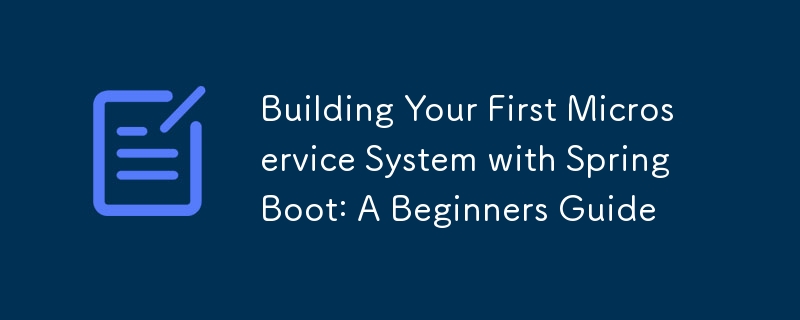

Dalam panduan ini, kami akan menelusuri penciptaan sistem perkhidmatan mikro yang ringkas tetapi komprehensif menggunakan Spring Boot. Kami akan merangkumi asas perkhidmatan mikro, menyediakan persekitaran yang diperlukan dan melaksanakan dua perkhidmatan mikro: OrderService dan InventoryService. Selain itu, kami akan menyepadukan penemuan perkhidmatan menggunakan Eureka dan Gateway API untuk mengurus penghalaan antara perkhidmatan.
Perkhidmatan mikro ialah gaya seni bina perisian di mana aplikasi dibina sebagai koleksi perkhidmatan kecil dan bebas yang berfungsi bersama. Setiap perkhidmatan adalah serba lengkap dan berkomunikasi dengan orang lain melalui API yang jelas, menjadikan sistem lebih fleksibel, berskala dan lebih mudah untuk diurus.
Seni bina sistem kami akan terdiri daripada dua perkhidmatan mikro: OrderService dan InventoryService. OrderService akan menggunakan pangkalan data hubungan (MySQL) untuk menyimpan butiran pesanan, manakala InventoryService akan menggunakan pangkalan data NoSQL (MongoDB) untuk mengurus data inventori. Kami juga akan melaksanakan penemuan perkhidmatan dengan Eureka dan menggunakan Gerbang API untuk permintaan penghalaan.
Sebelum kami bermula, pastikan anda telah memasang alatan berikut:
Buka fail application.properties dalam src/main/resources dan tambahkan konfigurasi berikut:
spring.datasource.url=jdbc:mysql://localhost:3306/orderservice spring.datasource.username=root spring.datasource.password=yourpassword spring.datasource.driver-class-name=com.mysql.cj.jdbc.Driver spring.jpa.hibernate.ddl-auto=update spring.jpa.show-sql=true spring.jpa.properties.hibernate.dialect=org.hibernate.dialect.MySQL8Dialect server.port=8081
Buat kelas entiti Pesanan dalam src/main/java/com/ordersystem/orderservice/model/Order.java:
package com.ordersystem.orderservice.model;
import lombok.AllArgsConstructor;
import lombok.Data;
import lombok.NoArgsConstructor;
import javax.persistence.*;
@Data
@AllArgsConstructor
@NoArgsConstructor
@Entity
@Table(name = "orders")
public class Order {
@Id
@GeneratedValue(strategy = GenerationType.IDENTITY)
private Long id;
private String product;
private int quantity;
private double price;
}
Buat antara muka OrderRepository dalam src/main/java/com/ordersystem/orderservice/repository/OrderRepository.java:
package com.ordersystem.orderservice.repository;
import com.ordersystem.orderservice.model.Order;
import org.springframework.data.jpa.repository.JpaRepository;
public interface OrderRepository extends JpaRepository<Order, Long> {
}
Buat kelas OrderService dalam src/main/java/com/ordersystem/orderservice/service/OrderService.java:
package com.ordersystem.orderservice.service;
import com.ordersystem.orderservice.model.Order;
import com.ordersystem.orderservice.repository.OrderRepository;
import org.springframework.beans.factory.annotation.Autowired;
import org.springframework.stereotype.Service;
import java.util.List;
@Service
public class OrderService {
@Autowired
private OrderRepository orderRepository;
public List<Order> getAllOrders() {
return orderRepository.findAll();
}
public Order getOrderById(Long id) {
return orderRepository.findById(id).orElse(null);
}
public Order createOrder(Order order) {
return orderRepository.save(order);
}
public void deleteOrder(Long id) {
orderRepository.deleteById(id);
}
}
Buat kelas OrderController dalam src/main/java/com/ordersystem/orderservice/controller/OrderController.java:
package com.ordersystem.orderservice.controller;
import com.ordersystem.orderservice.model.Order;
import com.ordersystem.orderservice.service.OrderService;
import org.springframework.beans.factory.annotation.Autowired;
import org.springframework.web.bind.annotation.*;
import java.util.List;
@RestController
@RequestMapping("/api/orders")
public class OrderController {
@Autowired
private OrderService orderService;
@GetMapping
public List<Order> getAllOrders() {
return orderService.getAllOrders();
}
@GetMapping("/{id}")
public Order getOrderById(@PathVariable Long id) {
return orderService.getOrderById(id);
}
@PostMapping
public Order createOrder(@RequestBody Order order) {
return orderService.createOrder(order);
}
@DeleteMapping("/{id}")
public void deleteOrder(@PathVariable Long id) {
orderService.deleteOrder(id);
}
}
Buka fail application.properties dalam src/main/resources dan tambahkan konfigurasi berikut:
spring.data.mongodb.uri=mongodb://localhost:27017/inventoryservice server.port=8082
Buat kelas entiti InventoryItem dalam src/main/java/com/ordersystem/inventoryservice/model/InventoryItem.java:
package com.ordersystem.inventoryservice.model;
import lombok.AllArgsConstructor;
import lombok.Data;
import lombok.NoArgsConstructor;
import org.springframework.data.annotation.Id;
import org.springframework.data.mongodb.core.mapping.Document;
@Data
@AllArgsConstructor
@NoArgsConstructor
@Document(collection = "inventory")
public class InventoryItem {
@Id
private String id;
private String product;
private int quantity;
}
Buat antara muka InventoryRepository dalam src/main/java/com/ordersystem/inventoryservice/repository/InventoryRepository.java:
package com.ordersystem.inventoryservice.repository;
import com.ordersystem.inventoryservice.model.InventoryItem;
import org.springframework.data.mongodb.repository.MongoRepository;
public interface InventoryRepository extends MongoRepository<InventoryItem, String> {
}
Create the InventoryService class in src/main/java/com/ordersystem/inventoryservice/service/InventoryService.java:
package com.ordersystem.inventoryservice.service;
import com.ordersystem.inventoryservice.model.InventoryItem;
import com.ordersystem.inventoryservice.repository.InventoryRepository;
import org.springframework.beans.factory.annotation.Autowired;
import org.springframework.stereotype.Service;
import java.util.List;
@Service
public class InventoryService {
@Autowired
private InventoryRepository inventoryRepository;
public List<InventoryItem> getAllItems() {
return inventoryRepository.findAll();
}
public InventoryItem getItemById(String id) {
return inventoryRepository.findById(id).orElse(null);
}
public InventoryItem createItem(InventoryItem item) {
return inventoryRepository.save(item);
}
public void deleteItem(String id) {
inventoryRepository.deleteById(id);
}
}
Create the InventoryController class in src/main/java/com/ordersystem/inventoryservice/controller/InventoryController.java:
package com.ordersystem.inventoryservice.controller;
import com.ordersystem.inventoryservice.model.InventoryItem;
import com.ordersystem.inventoryservice.service.InventoryService;
import org.springframework.beans.factory.annotation.Autowired;
import org.springframework.web.bind.annotation.*;
import java.util.List;
@RestController
@RequestMapping("/api/inventory")
public class InventoryController {
@Autowired
private InventoryService inventoryService;
@GetMapping
public List<InventoryItem> getAllItems() {
return inventoryService.getAllItems();
}
@GetMapping("/{id}")
public InventoryItem getItemById(@PathVariable String id) {
return inventoryService.getItemById(id);
}
@PostMapping
public InventoryItem createItem(@RequestBody InventoryItem item) {
return inventoryService.createItem(item);
}
@DeleteMapping("/{id}")
public void deleteItem(@PathVariable String id) {
inventoryService.delete
Item(id);
}
}
Open the application.properties file in src/main/resources and add the following configuration:
server.port=8761 eureka.client.register-with-eureka=false eureka.client.fetch-registry=false
Annotate the main application class in src/main/java/com/ordersystem/eurekaserver/EurekaServerApplication.java with @EnableEurekaServer:
package com.ordersystem.eurekaserver;
import org.springframework.boot.SpringApplication;
import org.springframework.boot.autoconfigure.SpringBootApplication;
import org.springframework.cloud.netflix.eureka.server.EnableEurekaServer;
@SpringBootApplication
@EnableEurekaServer
public class EurekaServerApplication {
public static void main(String[] args) {
SpringApplication.run(EurekaServerApplication.class, args);
}
}
Add the Eureka client dependency to both OrderService and InventoryService:
<dependency>
<groupId>org.springframework.cloud</groupId>
<artifactId>spring-cloud-starter-netflix-eureka-client</artifactId>
</dependency>
Add Eureka client configuration to the application.properties files:
eureka.client.service-url.defaultZone=http://localhost:8761/eureka/ spring.application.name=order-service
eureka.client.service-url.defaultZone=http://localhost:8761/eureka/ spring.application.name=inventory-service
Open the application.yml file in src/main/resources and add the following configuration:
server:
port: 8080
spring:
application:
name: api-gateway
cloud:
gateway:
routes:
- id: order-service
uri: lb://order-service
predicates:
- Path=/api/orders/**
- id: inventory-service
uri: lb://inventory-service
predicates:
- Path=/api/inventory/**
eureka:
client:
service-url:
defaultZone: http://localhost:8761/eureka/
Annotate the main application class in src/main/java/com/ordersystem/apigateway/ApiGatewayApplication.java with @EnableDiscoveryClient:
package com.ordersystem.apigateway;
import org.springframework.boot.SpringApplication;
import org.springframework.boot.autoconfigure.SpringBootApplication;
import org.springframework.cloud.client.discovery.EnableDiscoveryClient;
@SpringBootApplication
@EnableDiscoveryClient
public class ApiGatewayApplication {
public static void main(String[] args) {
SpringApplication.run(ApiGatewayApplication.class, args);
}
}
Use Postman or any other API client to test the endpoints through the API Gateway:
In this guide, we've built a simple microservices system using Spring Boot. We created two microservices (OrderService and InventoryService), integrated service discovery with Eureka, and set up an API Gateway for routing requests. This architecture allows for scalable and maintainable microservices that can be easily extended in the future.
Atas ialah kandungan terperinci Membina Sistem Perkhidmatan Mikro Pertama Anda dengan Spring Boot: Panduan Pemula. Untuk maklumat lanjut, sila ikut artikel berkaitan lain di laman web China PHP!




